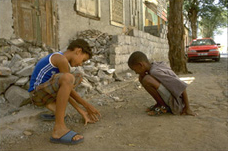Top Qs
Timeline
Chat
Perspective
Demographics of Cape Verde
From Wikipedia, the free encyclopedia
Remove ads
Demographic features of the population of Cape Verde include population density, ethnicity, education level, health of the populace, economic status, religious affiliations and other aspects of the population.
Cape Verde has about 540,000 inhabitants. A large proportion (236,000) of Cape Verdeans live on the main island, Santiago.[1] Many more live abroad in the Cape Verdean diaspora in mainland Africa, Europe, U.S., Brazil, et cetera.
The archipelago of Cape Verde was first discovered and claimed by Portuguese sailors working for the Portuguese Crown in 1456. Cape Verdeans are West African. Many foreigners from other parts of the world settled in Cape Verde as their permanent country.

The difficulty of survival in a country with few natural resources has historically induced Cape Verdeans to emigrate. In fact, of the more than 1 million people of Cape Verdean ancestry in the world, only a little more than one-third actually live on the islands. Some 500,000 people of Cape Verdean ancestry live in the United States, mainly in New England. Many people of Cape Verdean ancestry also live in Portugal, Netherlands, France, Italy and Senegal. Cape Verdean populations also settled Spain, Germany, Canada, and other CPLP countries (Angola, Brazil and Guinea-Bissau). Since independence from Portugal in 1975, a number of Cape Verdean students have continued to be admitted every year to Portuguese high schools, polytechnical institutes and universities, through bilateral agreements between the Portuguese and Cape Verdean governments.
Portuguese functions as a state language. Virtually all formal documents and official declarations are in Portuguese. But it is not the first language. Cape Verdean, commonly called Kriolu, is spoken as a mother tongue by virtually all Cape Verdeans, irrespective of social status or religious affiliation. Moreover, historical linguists often attribute Cape Verdean Creole as the oldest "New World" contact language. It is a "contact" language in the sense that it was born and evolved between linguistically different groups who, by necessity, had to create a common language to communicate with each other. There is a rich repertoire of literature and songs in Cape Verdean Creole. In religion, the majority of Cape Verdeans follow Catholic Christianity. There are some Protestants, Baháʼís and Muslims.
Remove ads
Population
Summarize
Perspective

According to the 2022 revision of the World Population Prospects[3][4] the total population was 587,925 in 2021, compared to only 178,000 in 1950. The proportion of children below the age of 15 in 2010 was 31.8%, 62.3% was between 15 and 65 years of age, while 5.9% was 65 years or older.[5]
Population by Sex and Age Group (Census 16.VI.2010):[6]
Population Estimates by Sex and Age Group (01.VII.2020) (Data refer to national projections.):[7]
Population by Sex and Age Group (Census 16.VI.2021): [8]
Remove ads
Vital statistics
Summarize
Perspective
Vital events of Cape Verde are not (yet) available for recent years. The Population Department of the United Nations prepared the following estimates.[5]
Registered births and deaths
Demographic and Health Surveys
Total fertility rate (TFR) (wanted fertility rate) and crude birth rate (CBR):[11]
Fertility data from 2005 (DHS Program):[12]
Life expectancy
Remove ads
Ethnic groups
Genetics
- The predominance of West African mitochondrial DNA haplotypes in their maternal gene pool, the major West African Y-chromosome lineage E3a was observed only at a frequency of 15.9%. Overall, these results indicate that gene flow from multiple sources and sex-specific patterns have been important in the formation of the genomic diversity in the Cabo Verde islands.[14]
Languages
- Portuguese (official), Kriolu[15]
According to results from 2016, 72.8% of the population aged 12 or above could speak a language besides Kriolu, and the vast majority of them spoke Portuguese, the official language of the country and the language from colonial time. Ability to speak non-Kriolu languages also varied greatly by age, with younger generations being substantially more likely to speak a non-creole language.[16]
Remove ads
Religion
- Catholic 77.3%, Protestant 3.7% (includes Church of the Nazarene 1.7%, Adventist 1.5%, Universal Kingdom of God 0.4%, and God and Love 0.1%), other Christian 4.3% (includes Christian Rationalism 1.9%, Jehovah's Witness 1%, Assembly of God 0.9%, and New Apostolic 0.5%), Islam 1.8%, Other 1.3%, None 10.8%, Unspecified 0.7% (2010 estimate)[15]
See also
References
External links
Wikiwand - on
Seamless Wikipedia browsing. On steroids.
Remove ads

